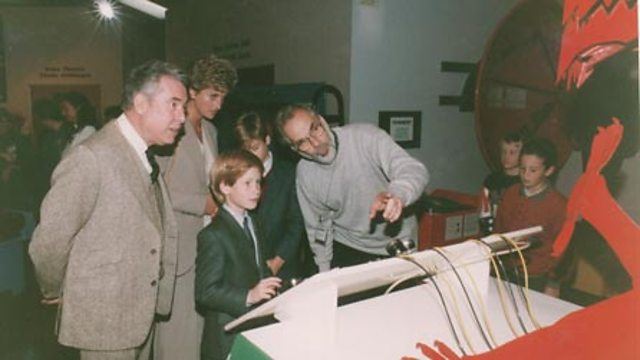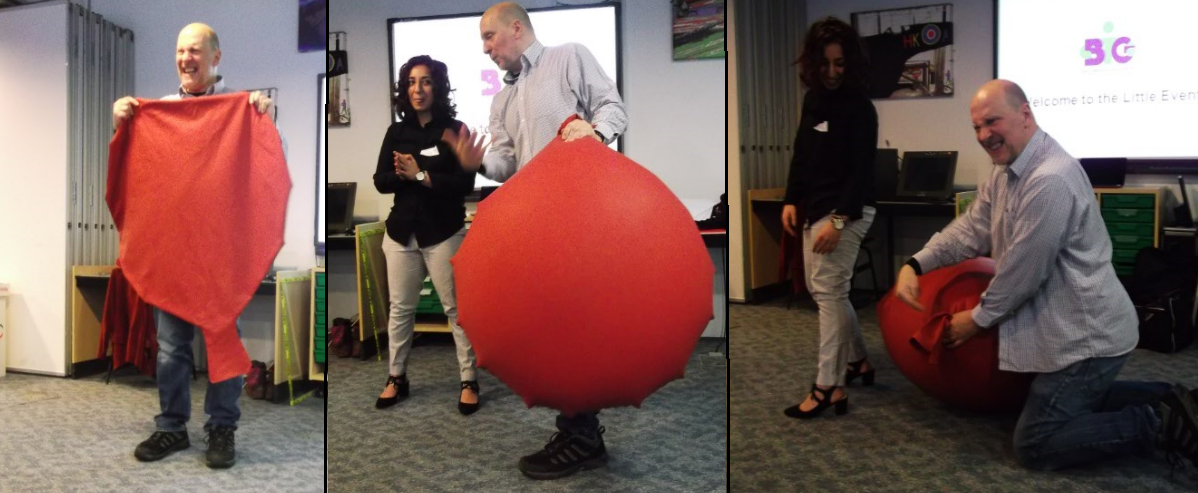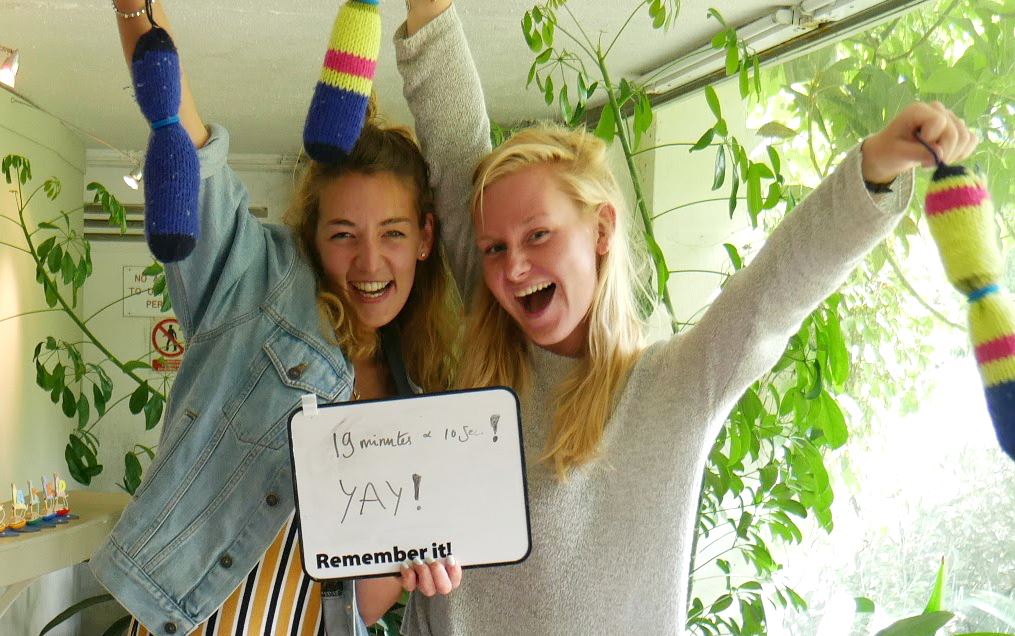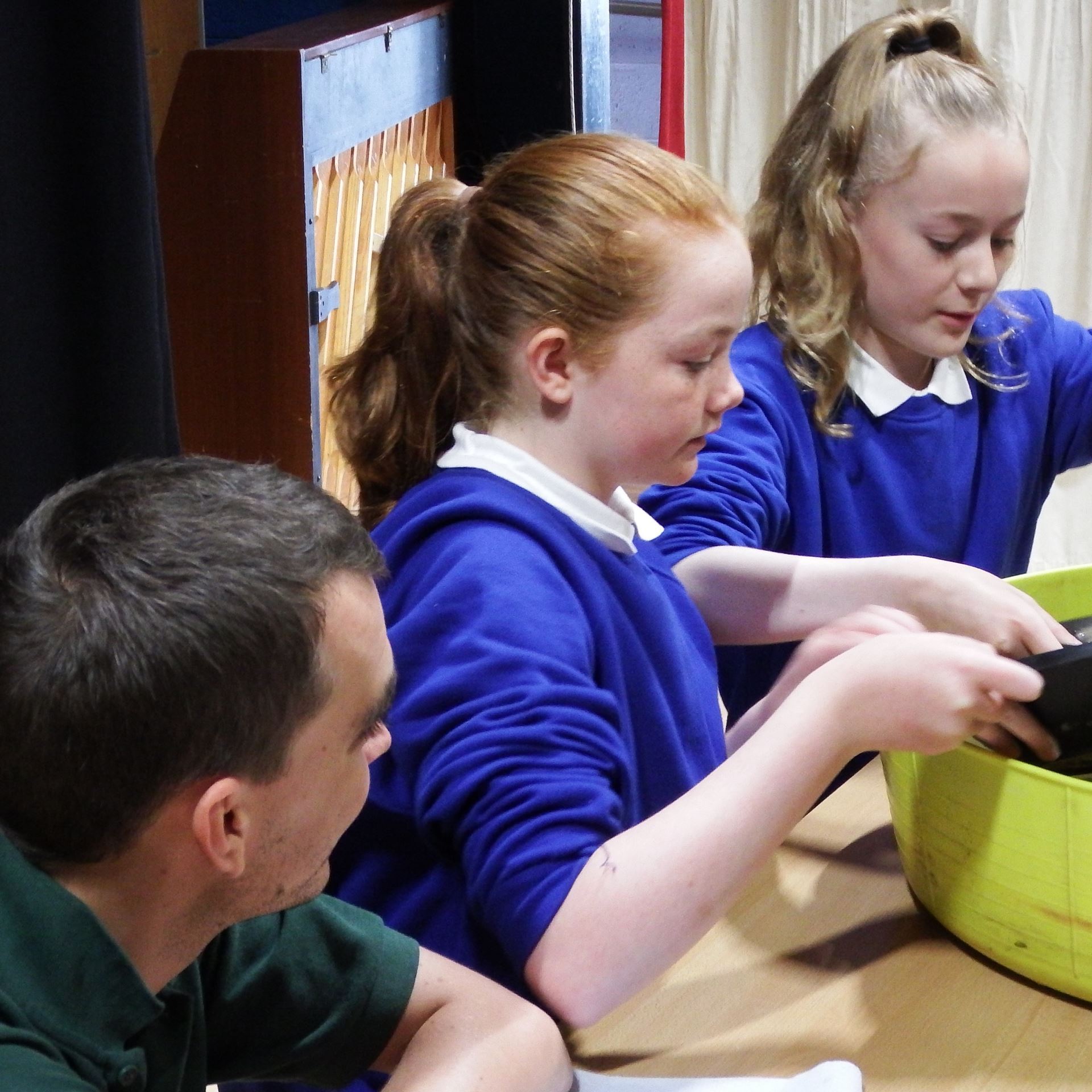BIG e-news: Spring 2017 edition - Issue 39

This year the BIG Event comes of age. 21 years - still growing and still supporting the science communication industry to develop. BIG helps individuals and organisations small and large to exchange skills on an equal footing and in a warm and friendly environment. We have some party plans to let you know about soon, but in the meantime, registration for the 21st BIG Event is now open, with early bird discounted rates until the end of the month.
Sarah Vining
Membership Services Manager, BIG
Professor John Beetlestone - An Obituary

Colin Johnson, Director, Techniquest, 1997-2004
Professor John Beetlestone MBE, the founding Director of Techniquest died earlier this year, and his legacy is one that the science centre sector will want to remember. Not only was he the first person in the UK to establish a science centre in its own purpose-built premises (in 1995), he was one of a small group of pioneers but for whom there might never have been any science centres in Britain at all.
The idea of setting up a hands-on science centre had been buzzing around in Prof Beetlestone’s mind since the 1970s but it was a meeting at the Science Museum in 1984 that provided the opportunity for which he had been waiting. Here it emerged that one of the Sainsbury family trusts (the Gatsby Charitable Foundation) was planning to allocate some funds to establish Regional Science Centres. During the return journey he decided, as he put it, that this was the moment to “put up or shut up”. He was successful in obtaining £60k which enabled him to set up Techniquest Phase 1, which opened shortly after Bristol’s Exploratory (also funded by Gatsby), in 1986.
‘Prof’, as he was always known to his staff, had three important criticisms of what he saw in the formal education system:
- it was geared to the needs of teachers, and didn't put the student first. This was to be student-led education
- it always found reasons for not doing things. This was to be a ‘can-do’ organisation
- the physical environment in schools was scruffy. Techniquest was always to look as if it had opened yesterday.
From very beginning Prof was wise enough to appreciate that a science centre could only succeed if it could play the delicate game of responding at the same time to a wide range of stakeholders. When he began discussions about the custom-built premises in Cardiff Bay it was all to do with urban regeneration, but at the same time he was assuring teachers that it would be a great resource for them, making sure that the politicians thoroughly understood the potential of the enterprise (and also its costs), that it would help to supply the scientists and engineers of the future, that it would provide a showcase for the applications of scientific research, that science for all was an entitlement as part of our culture – oh, and by the way, “the public has got to love us”. Let’s be sure we have lots of families at weekends and holidays to help pay the bills. It was his panoramic vision coupled with a clear sense of purpose that brought Techniquest into existence, and developed it to a point that during the 1990’s it could confidently advertise itself as “the UK’s leading science discovery centre”.
Prof Beetlestone inspired great loyalty and respect. He was clearly a man with a mission, and you were going to help him achieve it. He picked his people wisely, and then trusted them to get on with things - but woe betide you if you didn't. He had an acute eye for detail, but he was not a micromanager. He had an appreciation of style, but was never pretentious. He was a passionate internationalist, but he knew that the home audience mattered most of all. He recognised the talents in others, and wasn't afraid to employ people with skills that were different from his own. So he not only developed ideas, he developed people - whether by employing them, by setting up partnerships with them or even by ensuring that there was an MSc programme for young professionals in the field. His legacy is more than a set of exhibits within a building, it is a professional nursery which allowed very large numbers of people to realise the potential they never knew they had.
“On my count then – 3,2,1... RUBBER CHICKEN!” - A newbie's review of the Little Event

Caroline Wood, University of Sheffield
What on earth was I doing jumping up and down and screaming at the top of my lungs with forty other people at the ThinkTank Science Museum in Birmingham?! We were all here because we had one thing in common - we were budding young Science Communicators who wanted to turn our passion into a thrilling career. As for the jumping up and down…David Price was simply warming us up before his masterclass on presenting skills!
"Studies have found that we trust TV presenters more than journalists, even though they basically do the same job' David said. "The difference is that TV presenters bring a bit of themselves into what they present". Clearly Dave is an expert at doing this. Despite having no formal science qualifications, his passion for the subject ultimately led to him setting up Science Made Simple, which delivers interactive science workshops to schools and festivals. A key lesson for today was how to use props strategically to captivate audiences. What could be better, for instance, than a giant whoopee cushion to explain that sounds are caused by vibrations? When the hilarity following this demonstration had died down, it was our turn to come on stage and take it in turns to present mystery random objects from David’s bottomless bag. There were some very imaginative stories – particularly when we couldn’t work out what the object even were!
Later on, Bridget Holligan from ScienceOxford shared some sound advice in approaching the job market. For myself, I was reassured to hear that it isn't always necessary to have a specific science communication qualification and that a PhD can even be viewed favourably under some circumstances. "There are a growing number of science communication jobs in universities and an understanding of the research environment is often appreciated" said Bridget. But with competition so fierce, a PhD alone certainly isn’t enough to land a Sci-Comm job. We were all encouraged to get involved with as many activities as possible to bump up our CVs: science festivals, school projects, STEM Ambassador schemes and so on. "Your progression is your responsibility; no one else will do it for you” said Rachel.
We then had a lively speed dating round so we could pitch our burning questions to Sci-Comm workers from a range of sectors. It struck me that a career in Sci-Comm is rarely a straightforward progression: instead, periods of unemployment, freelancing or a series of temporary contracts seem to be the norm. Learning how to cope with (and bounce back from) redundancy was something many had learnt the hard way. "It is a very fluid field and lots of jobs are lost, but also created' said Dom MacDonald from the Wellcome Trust. “Remember that redundancy is almost never personal. The best thing you can do is to build a network of people around you to look out for you".
Dom then introduced us to his toolkit to make the daunting task of Project Evaluation “as painless as possible”. The most critical thing is to define what success looks like before you begin – “Only then can you be honest about what you have achieved'. For instance, if 300 people turn up to your event, how do you know if that is good or bad unless you already set a target? And take the time to consider which data is most relevant. “Just because you can measure it, that doesn't make it valuable” Dom said, “Instead, know what you value, then measure it". Unless you know what you want to look for, whole areas of success can be missed. A public engagement event that only attracts a low turnout may be regarded as a failure, but this could still have had good coverage in the local press, inspired those who attended and led to new collaborations.
To round off the day, Rachel Mason from BIG took us through a whirlwind tour of project management - a task that is “a bit like learning to repair a puncture if you want to cycle - it's necessary admin." It seems you can never start to plan too far in advance, and that working backwards from the event makes everything a lot easier. When it comes to budgeting, little extras quickly add up so always leave room for contingency. It's incredible how much more a litre of orange juice costs if you are paying someone to pour it into a jug!
The venue, the activities, the fascinating range of people .... the Little Event has certainly cemented my desire to enter the dynamic, exciting and rapidly evolving world of science communication. That said, I'm much more aware of the challenges that this could involve: multiple redundancies, constantly hunting for funding and having to live in London to name a few. But perhaps it's the challenge that makes the job more satisfying and the moments when you know you have inspired someone more worthwhile. And, as BIG and the Little Event have shown me, we are all in this together!
Archimedes’ Best Ideas 
Paul Stephenson, The Magic Mathworks Travelling Circus
The Royal Institution organise Saturday morning maths ‘masterclasses’ for children in two age ranges: primary (years 5/6) and secondary (years 8/9) up and down the country. Our own workshops are a mixture of teacher demonstrations and pupil experiments in the Nuffield style (in our case 30 children working in 15 pairs). When we develop a new one, we trial it with teachers (usually by giving a session at a conference) but also welcome input from other sources. On the practical side, that means BIG.
In our new secondary workshop, ‘Archimedes’ best ideas’, we hope to include activities on the following topics:
1. The ‘law of the lever’ (principle of moments), using mathematical balances.
2. Displacement (the ‘Eureka’ principle), with experiments on ‘the King’s Crown’ using the balances.
3. The stability of floating bodies. Simple experiment on centre of mass. Centre of buoyancy demonstrated. How principle of moments connects the two. The children asked to predict whether 3 wooden cylinders of the same density but different height: diameter ratios will be stable, then make the experiment.
4. The Archimedean screw as an inclined plane coiled up.
5. Mirrors. (That Archimedes used mirrors to ignite the Roman ships was probably just propaganda put out to alarm a navy already terrified by ‘the Claw’, but …) the children shine a collimated beam through a comb and shape a strip of front-silvered polystyrene till the rays converge on a point.
6. The sphere’s surface area. Volunteers assemble two prefabricated models where the hemisphere is approximated by a stack of frusta topped by a cone. The smaller fits a true (acetate) hemisphere, which in turn fits inside the larger. If we made a better-and-better larger model and a better-and-better smaller model by using more- and-more layers, we would approach the true shape, and therefore the true area, from above and below. We add in something that always surprises me: Down given meridia the children insert glass-headed pins at equal intervals of latitude and join up the points. The regions so formed have equal area. In the picture, that between the white and green pins is the same as that between the green and red pins, and between those and the pole.
7. The sphere’s volume. The children apply Pythagoras’ theorem to a vertical cross- section through a transparent model. With Polydron ‘Sphera’ pieces they shape wet sand into a cone and hemisphere of the same height and diameter. When they drop a matching cylinder over the top of the hemisphere and pack in sand from the cone, they find it fits perfectly.
8. The area between a point on a parabola and a chord parallel to the tangent at that point is 4/3 x the area of the triangle with the chord as base and the point as apex. We use a ‘proof without words’ to show why 

Escape the Cell – using an ‘escape room’ for public engagement
Sarah Keer-Keer & Maria Fanourgiaki, Wellcome Trust Centre for Cell Biology, University of Edinburgh
There is a growing enthusiasm for escape rooms, both online and in real spaces. In an escape room, visitors have to solve puzzles in order to ‘escape’ from a room. Our Wellcome Trust Centre for Cell Biology needed a new public engagement tool that could be used with young adults and teens and science communicator Maria Fanourgiaki had the idea that maybe using an escape room would work.
Inside the cell Aimed at young adults and teens, our scenario finds the 3-6 players trapped inside a cell. Going through the steps of DNA/RNA transcription and translation, they gather information to produce a transmembrane protein, which will release them.. Participants talk to researchers, work together and follow the clues to solve puzzles and crack biological codes against the clock (they have 30 minutes max). No prior knowledge is required. Researchers introduce the rules of the game and help the players if needed. At the end, the researchers and players discuss how the game links to their research. The game is portable and can be taken and run anywhere, but a room or a tent works best. We needed 6 minutes to reset the room after each team.
How did it go? We ran the room in total with 87 people and 11 different researchers mostly at the Royal Botanics Gardens Edinburgh. On a scale from 0-5 (where 0 is unsuccessful and 5 is excellent) the public’s average overall rating is 4.6. The problem-solving and the teamwork aspects of the game were the most enjoyable aspects to the audience. Everyone responded positively to the theme and some people suggested creating a longer one.
Comments included: ‘So practical! Really fun - lots of different elements to the game-made you think & use your brain’. ‘Well laid out room. 60 minute room please’. Many people reported they learnt something about cell biology by playing the game. For example: ‘The role of proteins, their building, and some fundamental aspects of cells’.
All the researchers were positive about their experience. They shared the players’ enthusiasm and celebrated with them each time a puzzle was solved. The game encouraged a relaxed conversation between the public and the researchers. Most volunteers said they would like to run Escape the Cell again.
Conclusions Overall this project was perfect in attracting and engaging our target audience of teens and young adults: they were keen to get involved and rated it highly. Links to current research could be strengthened by embedding it deeper into the game. We plan to run Escape the Cell again, maybe at a music festival. A good sustainable platform would be to collaborate directly with an escape room company and we are working towards that end.
Superbugs!
Nina Cromeyer Dieke, Longitude Prize

The Longitude Prize is a five-year challenge with a £10 million prize fund. Launched in November 2014 it aims to conserve antibiotics for future generations, revolutionising global healthcare. It commemorates the 300th anniversary of the Longitude Act of 1714, the first British challenge prize, to determine longitude at sea. It is looking to award one prize of £8m to a team that can develop a transformative, accurate, affordable, rapid, point of care diagnostic test that is easy to use, anywhere in the world. The Prize is being developed by Nesta, supported by Innovate UK.
The Longitude Prize, like many other prizes, wants to encourage a broad range of innovators to get involved to solve the challenge, so we raise awareness amongst the public to try and achieve this. At the same time, we know the problem of increasing resistance to antibiotics isn’t going to be solved through a diagnostic alone. We also need to raise awareness about the problem and what all of us can do to tackle resistance to antibiotics.
That's why we launched Superbugs, a free mobile game aimed at 11 to 16 year olds. It encourages them to fight antibiotic-resistant superbugs, using existing and new antibiotics. An easy-to-play and fun game, players try to survive for as long as they can against the most virulent strains of superbugs. The game shows players science facts at the end of each play so that young people understand the relationship between bacteria and antibiotics, and the importance of us winning this fight against the superbugs before it is too late. Although it was developed for 11 to 16 year olds, we've found that much younger children (and older adults!) also find it fun. Teachers have used the game in classrooms, we've taken it to various science fairs, and science centres have also showcased it.
Find out more about Superbugs and download it at www.longitudeprize.org/superbugs.
The Longitude Prize was launched by former UK Prime Minister David Cameron and will be awarded by the Longitude Committee chaired by Lord Martin Rees and including Dame Sally Davies, Baron Peter Piot and Professor Jeremy Farrar. To date we have 209 teams working on ideas, from 40 countries. We currently have a seed fund open, the Discovery Awards, to provide small grants to teams that need support to further develop their ideas to win the Prize. This call is open until 21st April 2017. The Prize will continue until it is won, or until the final deadline of September 2019.
Extracting Value from Big Data 
Denise De Gaetano, Data Scientist
Despite the large volumes of data, companies still struggle to access, manage and extract the information that their day-to-day processes generate. The growth of IT systems has provided these same companies, the ability to capture this potentially valuable data, within a number of applications, databases and organizations. Apart from a strong IT infrastructure, changes in the board and management, within a company also need to be carried out. This allows a number of departments to work in coordination and help ensure success of the utilization of the data at hand.
Understanding what is required out of the data, is the first step to generate the best results from the company and customer data. The strategy is to understand how the information can enable an improvement in the business. Although it is not essential that the business defines all of the end-results required, the more understanding there is of what is required, the more likely it is that the data, turns into the best useful information for the business.
Although the identification of an appropriate strategy is essential, the set of critical data assets is to be kept as small as possible, to allow the information to spread towards a number of further data assets and not be influenced by a priori information. Once the ball starts rolling, further attributes can be unveiled by a good data strategy and thus, further information obtained incrementally over time. Such information is usually linked to long-term value to the business across multiple systems and processes.
British Science Week 2017
Amelia Perry, British Science Association

British Science Week (BSW) is on its way and is set to take the UK by storm. For 10 days the scientific community will join forces with people and organisations all over the country. This celebration of science, technology, engineering and maths is organised by the British Science Association (BSA) and will feature fascinating and engaging events to suit everyone’s interests.
Taking place from 10-19 March 2017, there will be behind-the-scenes events at various Merlin attractions such as Thorpe Park, hundreds of schools doing simultaneous science demonstrations on Demo Day, mass participation of a Zooniverse project to monitor penguins and their habitats, a space-themed 10k race at Queen Elizabeth Olympic Park called Run the Solar System, plus much, much more.
People and organisations taking part in BSW have been adding their events to the BSA’s interactive events map, which will be publicised alongside the flagship events that are being organised by the BSA themselves.
For those wanting a more low-key, DIY Science Week, there are free activity packs available to download full of loads of inspiring ideas for primary, secondary and early years children. This year we’ve linked up with several exciting partners such as the Roald Dahl Literary Estates with some fantastic experiments inspired by George’s Marvellous Medicine. Other activities are featured from the Royal Meteorological Society, Food Teacher’s Centre, BBC Scientific Terrific and many more…
Pupils can also enter the annual poster competition and be in with a chance of winning an array of prizes, such as science/art activities. The theme of this year’s competition is also “Change”, to link in with the activity packs. Posters will be judged on how creative and well-researched the ideas are and how well the poster has been made or drawn.
Last BSW, thousands of events took place across the UK, engaging more than 1.6 million people, with activities taking place in schools and communities. The BSA want to make 2017 even bigger and better. To find out more information, visit the website.
 GeoBus: 5 years on the road
GeoBus: 5 years on the road
Jen Brooke, University of St Andrews
2017 marks five years since the GeoBus – an Earth Science education project at the University of St Andrews – first set off on its journey around Scottish secondary schools. Our milestone birthday was marked by a special activity day for local schools, including a talk on the Dinosaurs of Scotland which was live-streamed to schools across the country. Since its inception, GeoBus has worked with over 53,000 school pupils and its success is demonstrated through the high number of repeat bookings, and a completely full (if not double-booked!) schedule. In autumn 2016 a sister project, GeoBus UCL, was launched in London and is building similar momentum.
The aim of GeoBus is to introduce pupils to key geoscience topics through active learning, and support STEMM subjects in schools by providing resources that may not otherwise be readily available. We are proud to provide a bridge between industry, higher education and schools that encourages pupils to discover the education and employment opportunities available to them – both in Earth Science and in wider STEMM subject areas. Recently, some of our Discovery Event resources were accredited by the British Science Association for use by pupils in the Crest Award scheme and we have specifically been involved in supporting pupils from disadvantaged backgrounds to achieve their awards.
Due to the demand for school visits (and the small nature of our team) we don’t often get to visit larger public engagement events such as science festivals, but we are building our social media presence and becoming more involved in the science communication community – it’s certainly a great way to hear what everyone out there is up to, and a useful tool for interacting with a wider audience.
A standard GeoBus day can involve anything from encouraging pupils to taste soil samples (really crushed biscuits) to measuring and identifying dinosaur tracks, to trying to contain the mess of an elephant’s toothpaste volcano – and always involves the giant game of 3D Tetris that is packing the kit in to the van! Across schools (and even during workshops), pupils and their enthusiasm vary, but it’s our job to continue to inspire and engage pupils from all backgrounds by sharing our passion for our subject.
One of the GeoBus team was recently gifted a 1940’s ‘Teach Yourself Geology’ book, which quotes; “the scope of geology is very wide, taking the whole world and its history for its sphere”
If anything, the scope of Earth Science in the modern age is even broader – incorporating for example significant aspects of Planetary Science – but it certainly guarantees that a GeoBus day is never dull!
GeoBus is funded by sponsorship and we are very grateful for support from RCUK, industry and professional societies. For more information on the project and what we get up to, please visit the website or find us on Twitter (@GeoBus_StA).
SPINterns 
Kathie Bowden, Institute for Environmental Analytics and the UK Space Agency
The successful SPIN (Space Placements in Industry) project is calling for space sector hosts to benefit from picking from the top STEM undergraduates to work on a summer project.
As the 2016 SPIN Showcase event at the Royal Society showed, SPIN is a unique opportunity to talent scout and offers a wide range of skills from software development to marketing.
Astrosat, in Musselburgh, is just one of the 2016 hosts singing the praises of the scheme after employing their SPINtern, Lewis Dale, even though he still had a year of studies to complete.
Georgy Dean, Interim Chief Operating Officer, Astrosat, said: “Lewis is so proactive and he was so good at what he was doing that it didn’t take much management time to get him started – we had a few discussions and spent a little bit of time in advance putting together what we wanted him to do, but it wasn’t hard to get across.
“He worked very quickly – work that was meant to take him 8 weeks he finished in just 3 weeks.Good software developers are like gold dust. Before the end of his placement we offered him a permanent job. While Lewis is finishing his degree he is doing 16 paid hours a week and when he finishes he will work for us full-time.”
Georgy highly recommends SPIN for other companies in the space sector, saying: “I would encourage other companies to host a SPINtern and to set out a clear project. As a small company it was important for us to find someone who was proactive. People here didn’t want to have to ‘babysit’ and were concerned that the student’s finished work would not be good enough, but that didn’t happen at all - Lewis is fixing a lot of problems for us!”
Lewis, 23, who is studying Software Engineering as an undergraduate Masters at Aberystwyth, worked on a 10-week project, designing a Route Planner Dashboard to help disaster relief efforts, using EO data to identify safe routes around hazards such as landslides and areas of flooding in Vietnam. He says: “I have always had an interest in space but I hadn’t thought about going into the industry because I wasn’t a physicist, it always seemed to be more for Robotics students. Applying was a painless process, really easy – a quick form and a phone interview. It helped to be given a fair amount of information in the project brief. I had a good idea of what I was going to do which meant I could do preparation beforehand and feel up to speed when I arrived.”
SPIN 2017 is now open, visit the website.